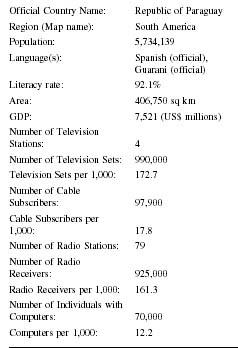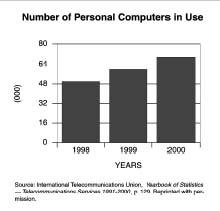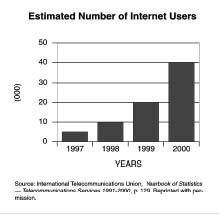Paraguay

Basic Data
| Official Country Name: | Republic of Paraguay |
| Region (Map name): | South America |
| Population: | 5,734,139 |
| Language(s): | Spanish (official),Guarani (official) |
| Literacy rate: | 92.1% |
| Area: | 406,750 sq km |
| GDP: | 7,521 (US$ millions) |
| Number of Television Stations: | 4 |
| Number of Television Sets: | 990,000 |
| Television Sets per 1,000: | 172.7 |
| Number of Cable Subscribers: | 97,900 |
| Cable Subscribers per 1,000: | 17.8 |
| Number of Radio Stations: | 79 |
| Number of Radio Receivers: | 925,000 |
| Radio Receivers per 1,000: | 161.3 |
| Number of Individuals with Computers: | 70,000 |
| Computers per 1,000: | 12.2 |

| Number of Individuals with Internet Access: | 40,000 |
| Internet Access per 1,000: | 7.0 |
Background & General Characteristics
Paraguay is a rather young democratic state continuing its journey toward freedom. The country is noted for its hydroelectric facility, Itaipu, the world's largest hydroelectric facility. It also is known for being the raison d'etre for the 1980s formation of the international Committee to Protect Journalists. After experiencing one of South America's longest military dictatorships, which ended in revolt in 1989, a new constitution was widely disseminated in 1992 and in 1993 Paraguay gained its first civilian president in almost 40 years.
Paraguay's nascent democratic government experienced significant turmoil in the late 1990s including an attempted coup in 1996, the assassination of a vice president, and the subsequent resignation of a president in 1999. President Luis Gonzalez Macchi, the former head of Paraguay's Senate, took office after the previous president resigned due to his suspected involvement in the 1999 assassination of the vice president. President Gonzalez appointed Paraguay's first coalition government in more than 50 years.
Paraguay was a Spanish colony until 1811. From 1811 until the military dictatorship was overthrown in 1989, the country experienced continued periods of military rule and anarchy. The country is landlocked and bordered by Bolivia to the north, Brazil to the east, and Argentina to the south and to the west. The north-to-south flowing Paraguay River diagonally divides Paraguay, and 90 percent of the country's people live in the southern region within 100 miles of its capital city of Asuncion.
One of South America's most ethnically and religiously homogeneous populations resides in Paraguay. In 2001 an estimated 5.73 million people lived in Paraguay. About 95 percent of the country's population is mestizo (Amerindian and Spanish mix) and 90 percent are Catholic. About 90 percent of Paraguayans can speak Guarani, one the country's two official languages. About 75 percent can speak the other official language, Spanish. Spanish is the dominant language in the schools, courts and is used in commerce. Guarani, the language of the indigenous population, is preferred in rural areas.
Paraguay's population is relatively young, with 38.9 percent aged 14 or younger in 2001; 56.4 percent were between the ages of 15 to 64; 4.7 percent were over age 65. Paraguay has slightly more males (50.2 percent) than females (49.8 percent); 92.5 percent of Paraguay's females over the age of 15 are literate, and 94.5 percent of its age 15 and older males are literate.
Primary schooling has been taught bilingually since the late 1990s. About 89 percent of Paraguay's children attended primary school in 1994. About 33 percent of Paraguay's youth go on to secondary schools after age 14. Higher education courses are taught in Spanish.
World Bank estimates that Paraguay's newspaper circulation in 1996 as 43 per 1,000 people. There were 182 radios per thousand residents in 1997, and 101 television per thousand in 1998. Telephone service, while improving, showed about 83 main telephone lines in use per 1,000 adults (age 15 and over) in 2001. The number of mobile telephones was nearly double that of main lines at 145 per 1,000 adults.
The metropolitan Asuncion area, with more than 1 million people, is Paraguay's principal advertising center. Television, radio and newspapers, respectively, are Asuncion's primary media for advertising. According to the Organization for American States, the television market penetrated 75.4 percent of Paraguay's 1.2 million homes in 1996; there were 150,000 homes with cable television.
Five daily newspapers are published in Asuncion: Diario abc Color, El Diario, Noticias, Dario La Nacion and Diario Ultima Hora. All five papers are published in Spanish. In rural areas where Guarani is the dominant language, radio is the dominant news and advertising media.
None of Paraguay's newspapers has a circulation of more than 50,000. Paraguay's leading newspaper, ABC Color, began publishing in 1967 and has a weekday circulation of 45,000. Covering national news and published in the mornings, ABC Color's Sunday edition has a circulation of about 50,000. Ultima Hora, another national newspaper, is published twice daily and has a circulation of about 35,000, while Noticias has a daily circulation of about 30,000.
Other notable publications are Aktuelle Rundschau, a weekly German language newspaper, and the Paraguay Ahora, a political magazine published only in Spanish. Circulation rates were not available for either publication.
Economic Framework
Paraguay is a socially and economically developing country. A relatively poor country, Paraguay's per capita Gross Domestic Product international ranking was 121 out of 226 countries in 2001 at U.S.$3,563. The country's transportation and communications sector contributed 4.9 percent (U.S.$54.6 million dollars) to Paraguay's GDP ($1,115.9 billion) in 1999. Value-added in manufacturing attributed to printing and publishing was $9.2 billion or 5.8 percent of the country's value-added in manufacturing of $159 billion.
Paraguay's economy is agrarian-based with 45 percent of the employed workforce working in agriculture related industries; 31 percent in industry and commerce; 19 percent in services; and 4 percent in government. The country also has a significant underground market economy, primarily in the unregistered sale of computers, sound equipment, cameras, liquor and cigarettes to Argentina and Brazil. According to the U.S. Department of State, the underground market economy may equal the formal economy in size. Losses due to the sale of pirated goods were estimated by the U.S. State Department to have been U.S.$221.3 million in 2000.
Agricultural workers in Paraguay usually are subsistence farmers. The slow and steady growth of the agricultural market after the early 1990s has been countered by high population growth (2.6 percent per year in 2001 alone) and forest clearances that have led to dramatic increases in the numbers of landless families.
Paraguayan wealth is concentrated. British Broadcasting Company in 2002 estimated that 60 percent of urban, and 80 percent of rural, Paraguayans were living in poverty. Per capita income was U.S.$1,700 in 2002, unemployment in the more urban areas was 7.2 percent and the underemployment rate was 21.4 percent.
The Republic of Paraguay is a member of the Rio Group, the Organization of American States, World Bank, International Atomic Energy Agency, the Latin American Integration Association (ALADI), INTELSAT, INTERPOL, and MERCOSUR (Southern Cone Common Market), which has low trade barriers with Argentina, Brazil and Uruguay. Paraguay has high tariffs on all goods and services going into the country from countries outside of MERCOSUR.
Although Paraguay's print and broadcast media are independently owned some have close ties to political parties. For example, the son-in-law of the military general leading the 1989 political coup took possession of Channel 9 and turned it into Sistema National de Television, and a former president has controlling interest in a company called Multimedia that includes a popular radio station and a daily newspaper, El Diario.
There are no significant multinational multimedia companies domiciled in Paraguay. The founder's feuding heirs split up the Red Privada de Communician, which did own the daily Noticias as well as a radio and a television station, in 1999. Since Paraguay is a small country with a concentrated population and advertising market, it is possible for media companies to have a national reach, such as it is, without having to own several different types of media companies.
Press Laws
Freedom of the press is guaranteed by Paraguay's constitution. However, journalists are readily subjected to defamation of character lawsuits under the country's criminal code enacted in 1998. Although journalists are not jailed for their work, penalties range from fines to imprisonment for libel, defamation and slander.
In 2001 the parliament passed and the president enacted Law 1728, which was supposed to make pubic records more accessible. In practicality, the law made it more difficult for journalists because it increased the paperwork required to get the information. The law was repealed September 24, 2001, after the media successfully campaigned for its repeal. The Ministry of Education has jurisdiction over Paraguay's copyright laws.
Censorship
There is no prior censorship of Paraguay's press. Nonetheless, Paraguay's criminal code is readily used to claim defamation of character so journalists are effectively restricted from complete freedom of expression.
State-Press Relations
While Paraguay's constitution guarantees freedom of the press, in 1999 journalists were arrested and Paraguayan police destroyed two radio stations. In 2001 a journalist was murdered and at least eight others were attacked or threatened by police or government officials in the same year. Also in 2001, the managing editor of ABC Color, was fined 470,880,000 guaranis (about U.S.$100,000) for having libeled Colorado Party Senator Juan Carolo Galaverna. In 2002 national police reportedly threatened two journalists after they witnessed the release of two leftist political group members who were allegedly kidnapped by officers of the Paraguayan state security.
Attitude toward Foreign Media
In 1999 a Brazilian journalist was beaten, reportedly by at least one police officer, after photographing a police station near the Brazilian border. There were no reported incidents of violence against foreign media after 1999.
U.S. journalists wishing to travel to Paraguay do not need visas for stays of up to three months. Foreign media representatives should have credentials certified and authenticated by either the Paraguayan Embassy or Consulate in the United States. Documents should be translated into Spanish.

News Agencies
Media contacts within the Paraguayan government are the responsibility of each ministry. No specific news agencies are readily identifiable. Paraguay.com , through service provided by WorldNews, does provide Internet-based up-to-date news coverage in English.
Broadcast Media
In 1998 there was one AM and one FM station, and six shortwave stations. Three of the shortwave stations were inactive. One radio station, Radio Nacional del Paraguay, is state-owned and the remaining are independently owned. In 2002 there were four television stations broadcasting: Teledifusora Paraguaya (Channel 13); Television Cerro Cora (Channel 9, commercial); Televisora Itapua (Channel 7, commercial); and SNT—Sistema Nacional de Television.
Electronic Media
Only the most well educated Paraguayans were likely to use the Internet in 2002. In 1999 there were 9.6 personal computers per 1,000 Paraguayans. In 1999 there were 2.43 Internet hosts per 1,000 residents. In 2000 there were an estimated 20,000 Paraguayan Internet users. Six Internet service providers operated in Paraguay in 2002. They were Highway, Infonet, Itapua Comunicaciones S.R.L, Planet, Quanta Net, and Uninet. Each of the five daily newspapers offers Web sites in Spanish; no Paraguayan news Web sites appeared in English in 2002.
Education and Training
University educated Paraguayans make up less than 1 percent of the total population. There are two main

Catholic University offers degrees in philosophy, history, psychology, sociology, political science, diplomatic studies, accounting, mathematics, business administration, education, nursing and pastoral studies. National University offers degree programs in agricultural studies, architecture, chemistry, dentistry, economics, exact and natural sciences, law and social sciences, medicine, library science, physics and mathematics, polytechnics, veterinary science and philosophy.
There were no specific journalism related degree programs for either university. The National University of Asuncion does offer Communication Studies through its Philosophy Department.
Summary
Paraguay's relatively weak economy helps to explain its equally weak communications sector. With 282 televisions and 264 radios per 1,000 adults, it appears Paraguayans rely on the broadcast media for their news rather than upon the written press. Although greater than 90 percent of Paraguayan adults are literate, many were not educated to read and write the Spanish language in which Paraguay's newspapers are published.
Notwithstanding the tenuous relations between Paraguay's media and the government, when the democratic state stabilizes—which will require significant economic recovery—there will be a great deal of room for growth in the mass media sector. None of the media have reached market saturation as yet and as the population becomes better educated, demand for mass media products will undoubtedly increase.
Significant Dates
- 1998: Criminal Code enacted pertaining to defamation, libel and slander.
- 2001: Law 1728 regarding public record accessibility enacted and later rescinded due to media pressure.
Bibliography
"2001 Special 301 Report: Paraguay." International Intellectual Property Alliance.
2002 National Trade Estimate Report on Foreign Trade Barriers U.S. Trade Representative. Washington, D.C., 2002.
Braumann, B., J. C. Jaramillo and E. Jenkner. "Paraguay: Selected Issues and Statistical Appendix." International Monetary Fund, January 21, 2000.
"Country Reports on Human Rights Practices—2000." U.S. Department of State, Bureau of Democracy, Human Rights, and Labor,, Washington, DC, February 23, 2001.
Country Reports: Paraguay. Committee to Protect Journalists. 1996, 1997, 1998, 1999, 2000, 2001.
"Cultural Industries in the Latin American Economy: Current Status and Outlook in the Context of Globalization." Organization for American States, Office of Cultural Affairs, Washington, DC, 1997.
"Focus on Paraguay." Latin American Forum, London, 2000.
"FY 2001 Country Commercial Guide: Paraguay." U.S. Department of State, Bureau, U.S. Embassy Asuncion, 2000.
Hanratty, Dannin M., and Sandra W. Meditz. Paraguay: A Country Study. Federal Research Division, U. S. Library of Congress, Washington, D.C., 1988.
Reporters Without Borders. "Paraguay—Annual report 2002." April 23, 2002.
U.S. Central Intelligence Agency (CIA). In The World Factbook 2002. Washington, D.C., 2002.
Sandra J. Callaghan